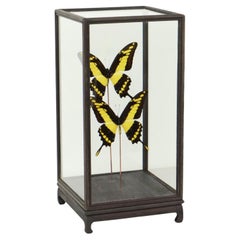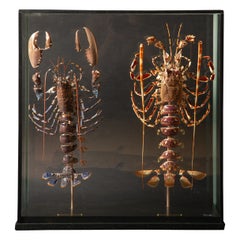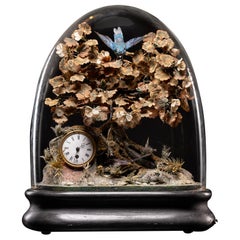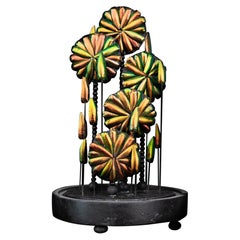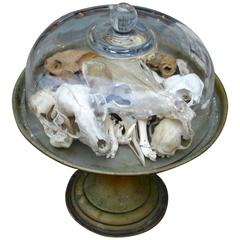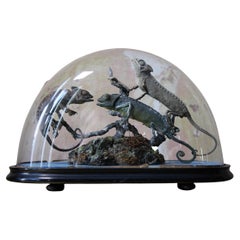Taxidermy Under Glass
21st Century and Contemporary Belgian Taxidermy
Glass, Wood
21st Century and Contemporary French Other Taxidermy
Shell, Glass, Wood
Antique 19th Century French Taxidermy
Metal
21st Century and Contemporary Belgian Taxidermy
Glass, Organic Material
Recent Sales
20th Century Taxidermy
Brass
Antique Late 19th Century Taxidermy
Natural Fiber, Blown Glass, Pine
Antique Late 19th Century English Late Victorian Taxidermy
Velvet, Natural Fiber, Glass, Pine
21st Century and Contemporary Dutch Taxidermy
21st Century and Contemporary English Victorian Taxidermy
Blown Glass, Softwood
21st Century and Contemporary Belgian Taxidermy
Organic Material
Antique 1880s French Black Forest Taxidermy
Glass, Wood, Feathers
Vintage 1980s Natural Specimens
Art Glass, Wood
Antique Late 19th Century English Late Victorian Taxidermy
Blown Glass, Pine
Antique Late 19th Century Taxidermy
Glass
21st Century and Contemporary Belgian Taxidermy
Organic Material, Blown Glass
21st Century and Contemporary Peruvian Taxidermy
Glass, Wood
21st Century and Contemporary Peruvian Taxidermy
Glass, Wood
Early 20th Century Asian Victorian Taxidermy
Bone, Shell, Glass, Wood
2010s Dutch Taxidermy
Animal Skin
Antique 19th Century Southeast Asian Taxidermy
Blown Glass, Organic Material
21st Century and Contemporary Belgian Taxidermy
Glass, Organic Material
19th Century Victorian Still-life Paintings
Canvas, Oil
19th Century Victorian Still-life Paintings
Canvas, Oil
20th Century Unknown Taxidermy
Steel
Early 20th Century French Taxidermy
Early 20th Century French Taxidermy
People Also Browsed
21st Century and Contemporary Taxidermy
Wood, Feathers
Antique Early 1900s British Historical Memorabilia
Bakelite
Antique Mid-19th Century French Gothic Revival Religious Items
Brass, Bronze
21st Century and Contemporary Angolan Taxidermy
Fur
Antique Late 19th Century Italian Natural Specimens
Animal Skin, Wood, Paper, Feathers
Antique Late 19th Century Italian Natural Specimens
Animal Skin, Wood, Paper, Feathers
Antique Late 19th Century Italian Natural Specimens
Malachite, Bronze
20th Century Taxidermy
Animal Skin
21st Century and Contemporary South African Natural Specimens
Bone
Early 20th Century Czech Taxidermy
Iron
Antique 19th Century English Taxidermy
Leather
20th Century African British Colonial Taxidermy
Iron
21st Century and Contemporary Dutch Taxidermy
Other
21st Century and Contemporary Dutch Victorian Taxidermy
Animal Skin
21st Century and Contemporary Taxidermy
Leather
Antique 19th Century British Victorian Taxidermy
Tortoise Shell, Animal Skin, Epoxy Resin, Paint
Taxidermy Under Glass For Sale on 1stDibs
How Much is a Taxidermy Under Glass?
- How are birds taxidermied?1 Answer1stDibs ExpertFebruary 17, 2023Birds are taxidermied through a multi-step process. First, the taxidermist removes the skin and flesh. Then, they wire the bird and mount it. Finally, they groom the bird, arranging the feathers to make the finished piece visually appealing. Shop a collection of taxidermied birds on 1stDibs.
- Is it legal to sell taxidermy?1 Answer1stDibs ExpertAugust 17, 2021Yes, it is legal to sell taxidermy as long as the animal is neither endangered nor obtained illegally. If you’re unsure, check your state’s laws regarding taxidermy to avoid committing a crime and/or being fined.
- What is faux taxidermy made of?1 Answer1stDibs ExpertApril 5, 2022What faux taxidermy is made of varies. Common materials include resin, metal, plaster and cardboard. Acrylic and other types of fabric may serve as fur, and eyes are often glass. Artisans often produce faux taxidermy out of a mix of materials. On 1stDibs, find a selection of taxidermy.
- 1stDibs ExpertMarch 22, 2022What birds are illegal to taxidermy depends on where you live. In the U.S., federal law bans the practice for certain species, and most states have additional restrictions. Consult your local regulations for specific information. On 1stDibs, shop a collection of taxidermy.
- 1stDibs ExpertApril 5, 2022No, cordial glasses are not the same as shot glasses. Typically, cordial glasses feature stems, while shot glasses do not. Normally, people use cordial glasses for serving liqueurs and dessert wines. Shot glasses are generally meant for hard spirits. Shop a range of antique and vintage glasses on 1stDibs.
- Is Tiffany glass real glass?1 Answer1stDibs ExpertOctober 7, 2024Yes, Tiffany glass is real glass. Louis Comfort Tiffany and his workshop, Tiffany Studios, produced many types of decorative glassware, such as opalescent glass, Favrile glass, streamer glass, fracture glass and ripple glass. While the colors, patterns, thicknesses and other characteristics of these materials vary, they are all forms of glass. Find a diverse assortment of antique Tiffany lamps on 1stDibs.
- 1stDibs ExpertApril 5, 2022Depression glass refers to any glass made during the period 1929-1939, and the Federal Glass Company was one of the most prolific makers of glass in America during that period. You can identify Federal Glassware by looking for the distinct shield with capital “F” stamped logo somewhere on the piece. Shop vintage Federal Glass on 1stDibs from some of the world’s top sellers.
- 1stDibs ExpertOctober 7, 2024The difference between Indiana glass and carnival glass is that one term describes glassware made by a specific manufacturer, and the other refers to a specific style of glassware. Carnival glass is glassware created by molding or pressing molten glass and then applying an iridescent finish that gives it a shimmering quality. Indiana glass is any glassware made by the Indiana Glass Company. Founded in 1907 in Dunkirk, Indiana, the company produced carnival glass as well as other types of glassware, including pressed, translucent Depression glass and enameled pressed Goofus glass. Find a wide variety of Indiana Glass Company glassware and other carnival glass on 1stDibs.
- 1stDibs ExpertApril 5, 2022A champagne glass, also known as a flute, is a tall and slender stemmed glass used for drinking champagne. A coupe glass is a wider and shorter stemmed glass that is also frequently used for serving champagne. The coupe glass can also be used for cocktails. Browse 1stDibs to find a beautiful array of champagne flutes and coupe glasses from top sellers.
- 1stDibs ExpertAugust 26, 2024The difference between a martini glass and a cocktail glass is the overall design. Used for serving martinis, cosmopolitans and other mixed drinks, martini glasses are typically larger than cocktail glasses and have conical bowls. Cocktail glasses are smaller by comparison and have a rounder shape. Also, nearly all martini glasses have stems, but cocktail glasses are available with and without stems. On 1stDibs, shop a selection of martini glasses and cocktail glasses.
- 1stDibs ExpertApril 5, 2022The difference between depression glass and carnival glass is color. Inspired by Tiffany stained glass, carnival glass usually shows off a variety of vibrant iridescent colors, while depression glass tends to feature only one color. Find a large selection of antique and vintage glassware on 1stDibs.
- 1stDibs ExpertOctober 5, 2021The difference between glass and crystal wine glasses is their composition. Mineral deposits like lead, magnesium or zinc strengthen crystal glass, rendering it thin but durable. On 1stDibs, you can find a variety of wine glasses and other glassware from different periods.
- 1stDibs ExpertApril 5, 2022The difference between stained glass and painted glass is how it is made. To create stained glass, an artisan adds pigments to the glass and then fires it at high temperatures to permanently change the appearance of the material. With painted glass, color is added after firing and may rub off or fade with age. You'll find a large selection of glass decorative objects on 1stDibs.
- 1stDibs ExpertSeptember 28, 2021There is no real difference between Venetian glass and Murano glass. While both Venetian glass and Murano glass come from Murano Island, Venice is a more popular location than Murano, hence it is called widely as Venetian glass. You can use both search terms to find the best piece for you on 1stDibs.
- 1stDibs ExpertNovember 20, 2024The difference between Tiffany glass and stained glass is that one relates to a brand and the other is a type of glass. Stained glass is colorful glass made by adding metallic oxides to molten glass during the blowing process. Named after Louis Comfort Tiffany who established Tiffany Studios, Tiffany glass involves a technique where copper foil, rather than the traditional lead oxide, serves as the joining material for individual stained glass pieces. Another key characteristic of Tiffany glass is that it often has an opalescent effect that creates variations in color and texture across its surface. On 1stDibs, shop a collection of Tiffany glass and other stained glass pieces.
- What is Culver glass?1 Answer1stDibs ExpertApril 26, 2024Culver glass is the term for glassware produced by the company Culver Ltd. It opened its doors in Brooklyn, New York, in 1939. The company is perhaps best known for its line of mid-century cocktail glasses trimmed in genuine 22-karat gold. Find a variety of Culver glass on 1stDibs.
- What is etched glass?1 Answer1stDibs ExpertFebruary 22, 2021Etched glass is a type of decorative glass which is the result of small cuts made to the glass. The cuts, which appear white, typically form patterns or images.
- What is a tulip glass?1 Answer1stDibs ExpertNovember 2, 2021A tulip glass has a bulbous body and a delicate flared top that resembles the lip of a tulip. These drinking glasses are mostly used for beer and are intended to promote flavor and aroma of pilsners and ales. We’re approaching happy hour — shop a range of tulip glasses on 1stDibs today.
- What is Latticino glass?1 Answer1stDibs ExpertMarch 22, 2022Latticino glass is a type of decorative glass produced using a glassblowing technique developed in Italy. Colored rods of glass known as canes are incorporated into the manufacturing process. You can shop for a variety of Latticino glass on 1stDibs.
- What is Harrach glass?1 Answer1stDibs ExpertApril 5, 2022Harrach glass is the term for glassware produced by the Harrach glassworks in Bohemia. Elias Muller began operating the facility on the land of Count Raimund von Harrach in 1712. Although the company remains in operation today under the name Sklarna Novosad & Syn Bohemia Harrachov, the term Harrach glass usually describes colorful pieces made during the Victorian age. Find a selection of Harrach glass on 1stDibs.
Read More
Medal-Worthy Memorabilia from Epic Past Olympic Games
Get into the games! These items celebrate the events, athletes, host countries and sporting spirit.
Ahoy! You’ve Never Seen a Collection of Sailor Art and Kitsch Quite Like This
French trendsetter and serial collector Daniel Rozensztroch tells us about his obsession with objects related to seafaring men.
39 Incredible Swimming Pools
It's hard to resist the allure of a beautiful pool. So, go ahead and daydream about whiling away your summer in paradise.
Pamela Shamshiri Shares the Secrets behind Her First-Ever Book and Its Effortlessly Cool Interiors
The sought-after designer worked with the team at Hoffman Creative to produce a monograph that beautifully showcases some of Studio Shamshiri's most inspiring projects.
Moroccan Artworks and Objects Take Center Stage in an Extraordinary Villa in Tangier
Italian writer and collector Umberto Pasti opens the doors to his remarkable cave of wonders in North Africa.
Montecito Has Drawn Royalty and Celebrities, and These Homes Are Proof of Its Allure
Hollywood A-listers, ex-pat aristocrats and art collectors and style setters of all stripes appreciate the allure of the coastal California hamlet — much on our minds after recent winter floods.
Whaam! Blam! Pow! — a New Book on Pop Art Packs a Punch
Publishing house Assouline and writer Julie Belcove have teamed up to trace the history of the genre, from Roy Lichtenstein, Andy Warhol and Yayoi Kusama to Mickalene Thomas and Jeff Koons.
The Sparkling Legacy of Tiffany & Co. Explained, One Jewel at a Time
A gorgeous new book celebrates — and memorializes — the iconic jeweler’s rich heritage.
